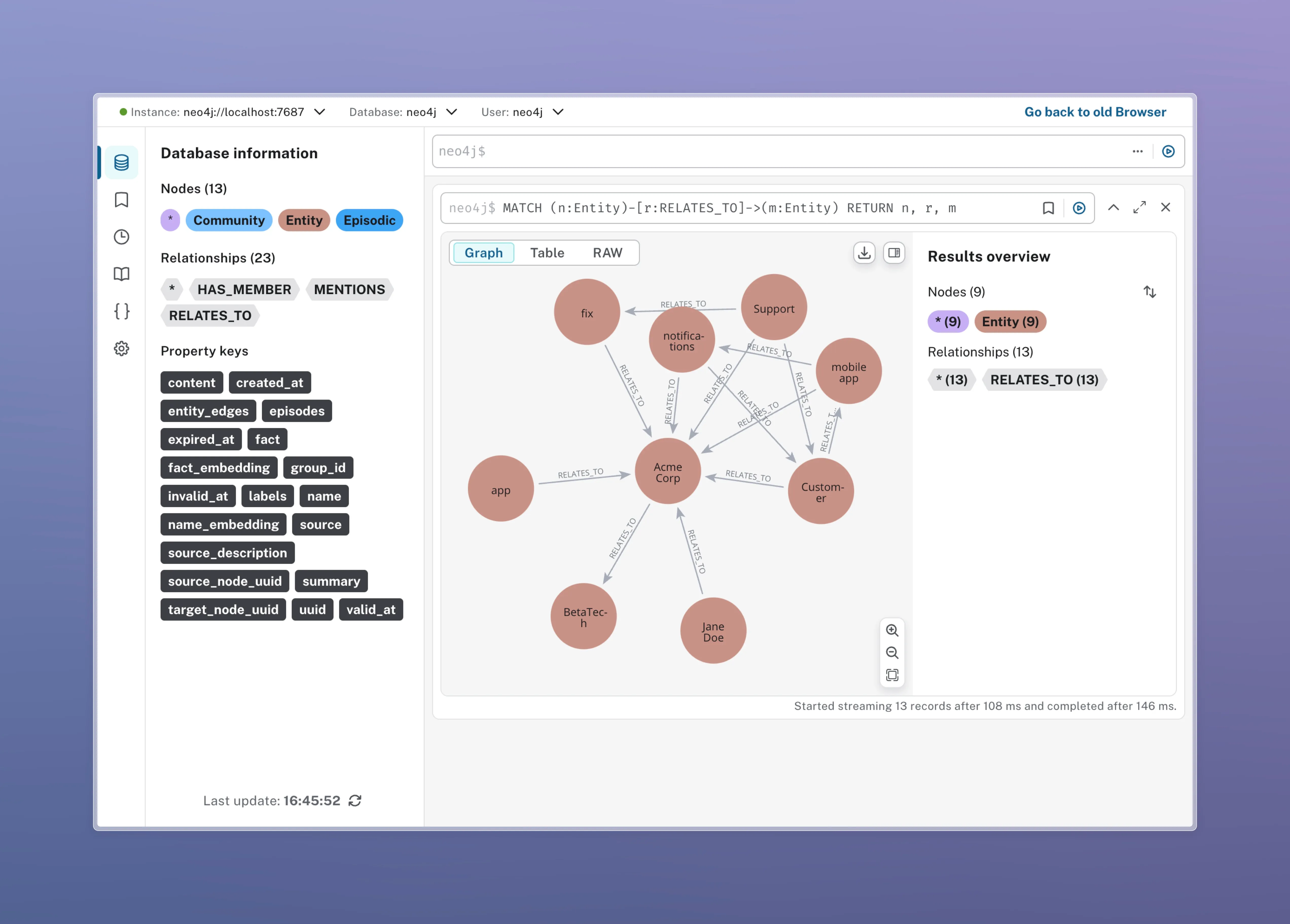Graphiti Integration
Overview
Graphiti is an open-source framework that transforms text, JSON, and chat content into queryable knowledge graphs using language models and graph databases. It excels at:
- Semantic indexing and retrieval
- Contextual search across structured/unstructured data
- Building long-term memory for AI agents
Why use Graphiti with Relax AI? Combine Neo4j’s graph capabilities with Relax’s powerful LLMs for context-aware applications.
Key Features
- Multi-format Ingestion: Process text, JSON, and chat messages
- Hybrid Search: Combine vector similarity and graph traversal
- Relax AI Integration: Use any Relax AI model for embeddings and reasoning
- Neo4j Backend: Lever industry-leading graph database
- Memory API: Create persistent knowledge for AI agents
Use Cases
- Building corporate knowledge graphs from documents and chats
- Creating contextual memory systems for AI copilots
- Real-time reasoning over dynamic data streams
- Customer support history analysis and retrieval
- Integrating Slack/PDF data into queryable knowledge
Quick Setup
-
Install Graphiti Core:
Terminal window pip install graphiti-core openai -
Graphiti requires Neo4j version 5.26 or higher. Either download and install Neo4j Desktop. Create a project, add a new database (Local DBMS), set password for user neo4j, and start the database or start a docker conrainer with the following command:
Terminal window docker run \--name neo4j-graphiti \-p 7474:7474 -p 7687:7687 \-e NEO4J_AUTH=neo4j/your_password \-e NEO4J_PLUGINS='["apoc"]' \neo4j:5.26-community
This exposes the HTTP (7474) and Bolt (7687) ports with neo4j/your_password credentials.
- Set required environment variables (can be in .env)
Terminal window export NEO4J_URI="bolt://localhost:7687"export NEO4J_USER="neo4j"export NEO4J_PASSWORD="your-password"export OPENAI_API_KEY="rak_..." # Replace with your Relax AI API keyexport OPENAI_BASE_URL="https://api.relax.ai/v1" - Intialize the Neo4j database schema, run the below sample script to create the schema:
db_schema.py import osimport asynciofrom graphiti_core import Graphitiasync def main():graphiti = Graphiti(os.getenv("NEO4J_URI"),os.getenv("NEO4J_USER"),os.getenv("NEO4J_PASSWORD"))await graphiti.build_indices_and_constraints(delete_existing=True)print("✅ Neo4j schema initialized")await graphiti.close()if __name__ == "__main__":asyncio.run(main()) - Now configure Graphiti with RelaxAI client along with a sample python example below.
import os, asyncio, jsonfrom graphiti_core import Graphitifrom graphiti_core.llm_client import LLMConfig, OpenAIClientfrom graphiti_core.embedder.openai import OpenAIEmbedder, OpenAIEmbedderConfigfrom graphiti_core.nodes import EpisodeTypefrom datetime import datetime, timezone
# LLM & Embedder setupllm_config = LLMConfig(model="DeepSeek-R1-0528", small_model="Llama-4-Maverick-17B-128E")llm_client = OpenAIClient(llm_config, None)embedder = OpenAIEmbedder(OpenAIEmbedderConfig(embedding_model="Mistral-7b-embedding"), None)
async def main(): graphiti = Graphiti( os.getenv("NEO4J_URI"), os.getenv("NEO4J_USER"), os.getenv("NEO4J_PASSWORD"), llm_client=llm_client, embedder=embedder )
await graphiti.build_indices_and_constraints(delete_existing=True) print("✅ Schema built")
# episodes episodes = [ { "name": "acquisition-news", "body": ( "In April 2025, Acme Corp acquired BetaTech for $25M. " "Jane Doe, VP of Strategy at Acme, will lead integration." ), "source": EpisodeType.text, "description": "Corporate acquisition announcement", "time": datetime(2025, 4, 1, tzinfo=timezone.utc) }, { "name": "customer-support-chat", "body": ( "Customer: I've been using your mobile app since last year, and the notifications aren't working.\n" "Support: Hi! We rolled out a fix in March 2025. Please update the app." ), "source": EpisodeType.message, "description": "Customer support chat", "time": datetime(2025, 4, 5, tzinfo=timezone.utc) }, { "name": "product-release", "body": json.dumps({ "product_id": "P-100", "name": "EcoSmart Thermostat", "manufacturer": "HomeTech Inc", "price": 199.99, "release_date": "2025-03-20T10:00:00Z", "features": ["Remote control", "Energy saving mode", "Voice integration"] }), "source": EpisodeType.json, "description": "Product catalog entry", "time": datetime(2025, 3, 20, tzinfo=timezone.utc) } ]
for ep in episodes: await graphiti.add_episode( name=ep["name"], episode_body=ep["body"], source=ep["source"], source_description=ep["description"], reference_time=ep["time"] ) print(f"✅ Added episode: {ep['name']}")
# Sample search results = await graphiti.search("Who did Acme Corp acquire?") print("Search results:", results)
await graphiti.close()
if __name__ == "__main__": asyncio.run(main())Advanced Usage
Namespaces (group_id)
You can assign a group_id when initializing Graphiti to separate memory graphs by application, tenant, or agent.
graphiti = Graphiti( uri, user, password, llm_client=llm_client, embedder=embedder, group_id="team-42")Hybrid Search
By default, graphiti.search() uses vector similarity + graph traversal. You can override search strategies, weights, or filter by time, entity type, or tag.
Graph Queries (Cypher)
Use Neo4j Browser or Bloom to run the following queries:
// Get all people involved in launchesMATCH (e:Event)<-[:INVOLVED_IN]-(p:Entity)WHERE e.name CONTAINS 'launch'RETURN p.name, e.date
// Find related support ticketsMATCH (t:Ticket)-[r:RELATED_TO]->(p:Product)RETURN t, p, rYou should see graph nodes representing entities, events, and relationships in the Neo4j Browser.

Troubleshooting
- Connection Issues: Verify Neo4j is running and credentials are correct
- Schema Errors: Run
build_indices_and_constraints(delete_existing=True) - Model Compatibility: Ensure Relax AI model names match available models